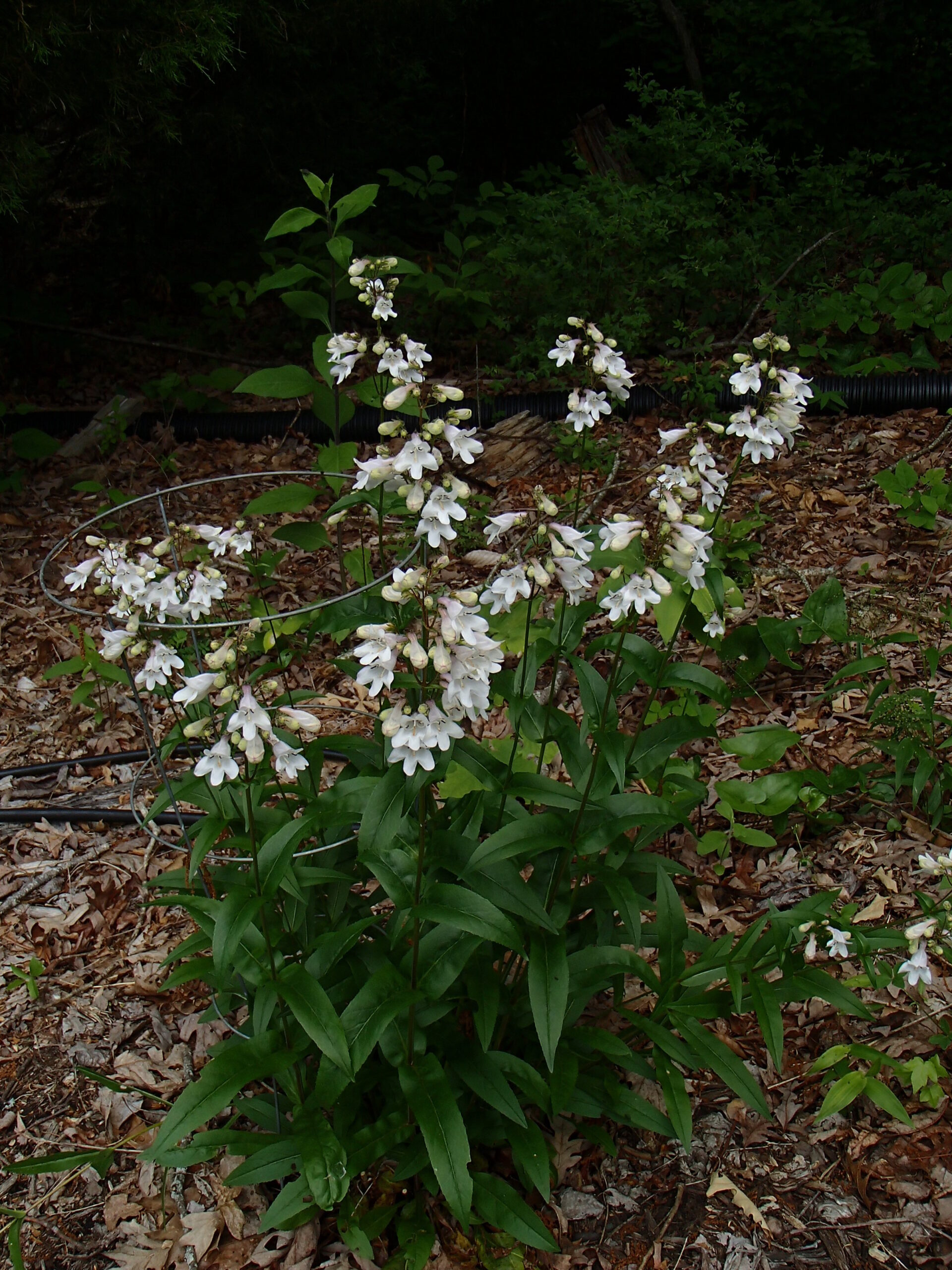This herbaceous perennial is most rewarding to grow. From an attractive persistent basal rosette, vigorous, sturdy stems with dark green foliage rise to about 3 feet, terminating in branched panicles of numerous, showy, bright white, 1-inch tubular flowers which last a long time for an early season plant (spring to early summer). The tubular flower structure attracts long-tongued bees and hummingbirds to the garden, and after the spent stems have been cut away, the basal rosette, dark green with accents of red, is a welcome winter groundcover. Only a few counties in the NC mountains report this plant; it is much more common both in the north central and northeast states and just the other side of the Mississippi from Louisiana up to Wisconsin; (mostly absent to states south of us). Indigenous to dry or mesic prairies, savannas, edges and clearings of floodplain or upland forests, it also thrives in disturbed fields and along railroad rights of way. In cultivation, White Beardtongue is easy to grow in full or partial sun, preferring well-drained, acid, loamy and sandy soils. However, it is adaptable and will tolerate clay and high pH as well.
NURSERY HOURS
Wednesday: 10-4 Thursday: 10-6 Friday-Saturday: 10-4 Sunday: 12-4
Penstemon digitalis

Key Info
Scientific Name: Penstemon digitalis Nutt. ex Sims
Common Names: Foxglove Penstemon (or Beardtongue), Talus Slope Penstemon (or Beardtongue), Mississippi Penstemon (or Beardtongue), Smooth White Penstemon (or Beardtongue)
Family Names: Plantaginaceae (Plantain Family)
Plant Type: Herbaceous perennial
Leaf Retention: Semi-evergreen
Flower Color: White
Special Characteristics: Reported to be deer resistant., Good fresh cut flowers, Tolerates drought, Attracts bees, Attracts Hummingbirds, Tolerates dry shade, Attracts birds, Rhizomatous, Tolerates heat
Additional Info
Habit: A red-purple accented persistent basal rosette gives rise to strong stems in an upright clump. The root is a tap root, and short rhizomes can produce new plantlets around the base.
Height: 2' to 4'
Spread: 1' to 2'
Soil Conditions: Wet or moist, well drained soils, fertile, prefers acid but tolerates alkaline pH, loams, clay, clay loams, and sandy loams
Leaves: Rosettes of basal leaves are medium green, with reddish streaks, variable in shape (oval to lance-shaped), up to 6" long and 2½" wide, with smooth margins. The opposite leaves on the stalks are similar in size, but more lanceolate in shape than the basal leaves, often glossy with occasional red tints, with finely toothed margins.
Flowers (or reproductive structures: During late spring or early summer for about a month, the stems terminate in showy branched flower panicles. The florets are trumpet-shaped, lobed (a lower lip with 3 lobes and an upper lip with 2 lobes) and about 1” long. abruptly swollen in the middle. The outer surface of the corolla tube is white or pale pink and the inner surface is often marked with violet nectar guides. The name Penstemon is derived from "penta', or five, referring to the five stamens within, four of them fertile and the fifth one sterile with fine hairs ("Beard tongue"). There is no floral scent.
Fruit: Flowers give way to small, oval capsules full of tiny, brown/grey, finely pitted and irregularly shaped seeds which persist into early winter.
Natural Distribution: These plants occur in both high quality habitats (dry or mesic prairies, savannas, edges and clearings of floodplain or upland forests) and disturbed habitats (abandoned fields, roadsides, railroad tracks and rights of way) -- both in wetlands and well drained sites.
USDA Hardiness Zone: 3 to 8
USDA Wetland Indicator Status in NC: FAC
Pollination: Bees of many types, especially long-tongued bees.
Wildlife Connections: Attracts honeybees, bumble bees, mason bees and large leaf-cutting bees. Other pollinators such as hummingbirds, sphinx moths and butterflies will sip nectar from the flowers. Caterpillars of several moth species feed on the foliage. The seeds are not often eaten by birds. Although the foliage is generally not preferred by mammalian herbivores, it will be browsed in the absence of other food sources (Illinoiswildflower.info)
Propagation: Root division in fall or early spring; also by seeds or by softwood cuttings during the growing season.
